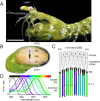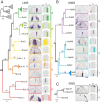Exceptional diversity of opsin expression patterns in Neogonodactylus oerstedii (Stomatopoda) retinas
- PMID: 32241889
- PMCID: PMC7183149
- DOI: 10.1073/pnas.1917303117
Exceptional diversity of opsin expression patterns in Neogonodactylus oerstedii (Stomatopoda) retinas
Abstract
Stomatopod crustaceans possess some of the most complex animal visual systems, including at least 16 spectrally distinct types of photoreceptive units (e.g., assemblages of photoreceptor cells). Here we fully characterize the set of opsin genes expressed in retinal tissues and determine expression patterns of each in the stomatopod Neogonodactylus oerstedii Using a combination of transcriptome and RACE sequencing, we identified 33 opsin transcripts expressed in each N. oerstedii eye, which are predicted to form 20 long-wavelength-sensitive, 10 middle-wavelength-sensitive, and three UV-sensitive visual pigments. Observed expression patterns of these 33 transcripts were highly unusual in five respects: 1) All long-wavelength and short/middle-wavelength photoreceptive units expressed multiple opsins, while UV photoreceptor cells expressed single opsins; 2) most of the long-wavelength photoreceptive units expressed at least one middle-wavelength-sensitive opsin transcript; 3) the photoreceptors involved in spatial, motion, and polarization vision expressed more transcripts than those involved in color vision; 4) there is a unique opsin transcript that is expressed in all eight of the photoreceptive units devoted to color vision; and 5) expression patterns in the peripheral hemispheres of the eyes suggest visual specializations not previously recognized in stomatopods. Elucidating the expression patterns of all opsin transcripts expressed in the N. oerstedii retina reveals the potential for previously undocumented functional diversity in the already complex stomatopod eye and is a first step toward understanding the functional significance of the unusual abundance of opsins found in many arthropod species' visual systems.
Keywords: Stomatopoda; evolution; in situ hybridization; opsin; retinal expression.
Conflict of interest statement
The authors declare no competing interest.
Figures




Similar articles
-
The molecular genetics and evolution of colour and polarization vision in stomatopod crustaceans.Ophthalmic Physiol Opt. 2010 Sep;30(5):460-9. doi: 10.1111/j.1475-1313.2010.00762.x. Ophthalmic Physiol Opt. 2010. PMID: 20883329 Review.
-
The evolution of complexity in the visual systems of stomatopods: insights from transcriptomics.Integr Comp Biol. 2013 Jul;53(1):39-49. doi: 10.1093/icb/ict060. Epub 2013 May 31. Integr Comp Biol. 2013. PMID: 23727979
-
Molecular diversity of visual pigments in Stomatopoda (Crustacea).Vis Neurosci. 2009 May-Jun;26(3):255-65. doi: 10.1017/S0952523809090129. Epub 2009 Jun 18. Vis Neurosci. 2009. PMID: 19534844
-
Ultraviolet vision in larval Neogonodactylus oerstedii.J Exp Biol. 2022 Feb 1;225(3):jeb243256. doi: 10.1242/jeb.243256. Epub 2022 Feb 10. J Exp Biol. 2022. PMID: 35029279
-
Reconstructing the ancestral butterfly eye: focus on the opsins.J Exp Biol. 2008 Jun;211(Pt 11):1805-13. doi: 10.1242/jeb.013045. J Exp Biol. 2008. PMID: 18490396 Review.
Cited by
-
Development and maintenance of vision's first synapse.Dev Biol. 2021 Aug;476:218-239. doi: 10.1016/j.ydbio.2021.04.001. Epub 2021 Apr 10. Dev Biol. 2021. PMID: 33848537 Free PMC article. Review.
-
Deep conservation complemented by novelty and innovation in the insect eye ground plan.Proc Natl Acad Sci U S A. 2025 Jan 7;122(1):e2416562122. doi: 10.1073/pnas.2416562122. Epub 2024 Dec 30. Proc Natl Acad Sci U S A. 2025. PMID: 39793041 Free PMC article.
-
The chromosome-level genome provides insights into the adaptive evolution of the visual system in Oratosquilla oratoria.BMC Biol. 2025 Feb 6;23(1):38. doi: 10.1186/s12915-025-02146-6. BMC Biol. 2025. PMID: 39915724 Free PMC article.
-
The Gluopsins: Opsins without the Retinal Binding Lysine.Cells. 2022 Aug 6;11(15):2441. doi: 10.3390/cells11152441. Cells. 2022. PMID: 35954284 Free PMC article.
-
The evolution of red color vision is linked to coordinated rhodopsin tuning in lycaenid butterflies.Proc Natl Acad Sci U S A. 2021 Feb 9;118(6):e2008986118. doi: 10.1073/pnas.2008986118. Proc Natl Acad Sci U S A. 2021. PMID: 33547236 Free PMC article.
References
-
- Schram F. R., et al. , “Subclass Hoplocarida Calman, 1904: Order Stomatopoda Latreille, 1817” in Treatise on Zoology—Anatomy, Taxonomy, Biology; The Crustacea; Revised and Updated, as Well as Extended from the Traité de Zoologie, Vaupel Klein J. C., Charmantier-Daures M., Schram F. R., Eds. (Brill, Leiden-Boston, 2013), Vol. 4, pp. 179–356.
-
- Marshall N. J., A unique colour and polarization vision system in mantis shrimps. Nature 333, 557–560 (1988). - PubMed
-
- Marshall N. J., Land M. F., King C. A., Cronin T. W., The compound eyes of mantis shrimps (Crustacea, Hoplocarida, Stomatopoda). I. Compound eye structure: The detection of polarized light. Philos. Trans. R. Soc. Lond. B Biol. Sci. 334, 33–56 (1991).
-
- Marshall N. J., Land M. F., King C. A., Cronin T. W., The compound eyes of mantis shrimps (Crustacea, Hoplocarida, Stomatopoda). II. Colour pigments in the eyes of stomatopod crustaceans: Polychromatic vision by serial and lateral filtering. Philos. Trans. R. Soc. Lond. B Biol. Sci. 334, 57–84 (1991).
-
- Marshall J., Cronin T. W., Kleinlogel S., Stomatopod eye structure and function: A review. Arthropod Struct. Dev. 36, 420–448 (2007). - PubMed
Publication types
MeSH terms
Substances
Associated data
- Actions
- Actions
LinkOut - more resources
Full Text Sources

